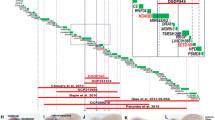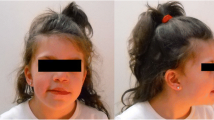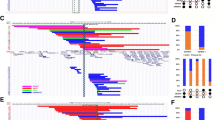Abstract
Proper epigenetic regulation processes are crucial in the normal development of the human brain. An ever-increasing group of neurodevelopmental disorders due to derangements of epigenetic regulation involve both microdeletion and monogenic syndromes. Some of these syndromes have overlapping clinical phenotypes due to haploinsufficiency-sensitive genes involved in microdeletions. It was shown recently that the ZMYND11 gene has important functions in epigenetic regulation as an unconventional transcription co-repressor of highly expressed genes, possibly acting in the repression of cryptic transcription from gene bodies. The aim of our study was to compare the clinical phenotypes of patients with 10p15.3 deletions with the phenotypes of patients with loss-of-function ZMYND11 mutations. The results of our study further confirm that the ZMYND11 gene is the critical gene for the clinical phenotype of 10p15.3 microdeletion involving the terminal ~4 Mb of chromosome 10p. In addition, accumulating clinical data allow for further characterisation of this syndrome, including neurodevelopmental disorder, characteristic dysmorphic features and some other more frequent symptoms, such as behavioural disturbances, hypotonia, seizures, low birth weight, short stature in those older than 10 years of age, genitourinary malformations and recurrent infections.


Similar content being viewed by others
References
Bartsch O, Kress W, Kempf O, Lechno S, Haaf T, Zechner U (2010) Inheritance and variable expression in Rubinstein–Taybi syndrome. Am J Med Genet A 152A(9):2254–2261
Blackburn PR, Barnett SS, Zimmermann MT, Cousin MA, Kaiwar C, Pinto E Vairo F, Niu Z, Ferber MJ, Urrutia RA, Selcen D, Klee EW, Pichurin PN (2017) Novel de novo variant in EBF3 is likely to impact DNA binding in a patient with a neurodevelopmental disorder and expanded phenotypes: patient report, in silico functional assessment, and review of published cases. Cold Spring Harb Mol Case Stud 3(3):a001743
Chao HT, Davids M, Burke E, Pappas JG, Rosenfeld JA, McCarty AJ, Davis T, Wolfe L, Toro C, Tifft C, Xia F, Stong N, Johnson TK, Warr CG; Undiagnosed Diseases Network, Yamamoto S, Adams DR, Markello TC, Gahl WA, Bellen HJ, Wangler MF, Malicdan MC (2017) A syndromic neurodevelopmental disorder caused by de novo variants in EBF3. Am J Hum Genet 100(1):128–137
Ciuladaite Z, Preiksaitiene E, Utkus A, Kučinskas V (2014) Relatives with opposite chromosome constitutions, rec(10)dup(10p)inv(10)(p15.1q26.12) and rec(10)dup(10q)inv(10)(p15.1q26.12), due to a familial pericentric inversion. Cytogenet Genome Res 144(2):109–113
Cobben JM, Weiss MM, van Dijk FS, De Reuver R, de Kruiff C, Pondaag W, Hennekam RC, Yntema HG (2014) A de novo mutation in ZMYND11, a candidate gene for 10p15.3 deletion syndrome, is associated with syndromic intellectual disability. Eur J Med Genet 57(11–12):636–638
Coe BP, Witherspoon K, Rosenfeld JA, van Bon BW, Vulto-van Silfhout AT, Bosco P, Friend KL, Baker C, Buono S, Vissers LE, Schuurs-Hoeijmakers JH, Hoischen A, Pfundt R, Krumm N, Carvill GL, Li D, Amaral D, Brown N, Lockhart PJ, Scheffer IE, Alberti A, Shaw M, Pettinato R, Tervo R, de Leeuw N, Reijnders MR, Torchia BS, Peeters H, O’Roak BJ, Fichera M, Hehir-Kwa JY, Shendure J, Mefford HC, Haan E, Gécz J, de Vries BB, Romano C, Eichler EE (2014) Refining analyses of copy number variation identifies specific genes associated with developmental delay. Nat Genet 46(10):1063–1071
DeScipio C, Conlin L, Rosenfeld J, Tepperberg J, Pasion R, Patel A, McDonald MT, Aradhya S, Ho D, Goldstein J, McGuire M, Mulchandani S, Medne L, Rupps R, Serrano AH, Thorland EC, Tsai AC, Hilhorst-Hofstee Y, Ruivenkamp CA, Van Esch H, Addor MC, Martinet D, Mason TB, Clark D, Spinner NB, Krantz ID (2012) Subtelomeric deletion of chromosome 10p15.3: Clinical findings and molecular cytogenetic characterization. Am J Med Genet A 158A(9):2152–2161
Farwell KD, Shahmirzadi L, El-Khechen D, Powis Z, Chao EC, Tippin Davis B, Baxter RM, Zeng W, Mroske C, Parra MC, Gandomi SK, Lu I, Li X, Lu H, Lu HM, Salvador D, Ruble D, Lao M, Fischbach S, Wen J, Lee S, Elliott A, Dunlop CL, Tang S (2015) Enhanced utility of family-centered diagnostic exome sequencing with inheritance model-based analysis: results from 500 unselected families with undiagnosed genetic conditions. Genet Med 17(7):578–586
Grillo E, Lo Rizzo C, Bianciardi L, Bizzarri V, Baldassarri M, Spiga O, Furini S, De Felice C, Signorini C, Leoncini S, Pecorelli A, Ciccoli L, Mencarelli MA, Hayek J, Meloni I, Ariani F, Mari F, Renieri A (2013) Revealing the complexity of a monogenic disease: rett syndrome exome sequencing. PLoS One 8(2):e56599
Harms FL, Girisha KM, Hardigan AA, Kortüm F, Shukla A, Alawi M, Dalal A, Brady L, Tarnopolsky M, Bird LM, Ceulemans S, Bebin M, Bowling KM, Hiatt SM, Lose EJ, Primiano M, Chung WK, Juusola J, Akdemir ZC, Bainbridge M, Charng WL, Drummond-Borg M, Eldomery MK, El-Hattab AW, Saleh MA, Bézieau S, Cogné B, Isidor B, Küry S, Lupski JR, Myers RM, Cooper GM, Kutsche K (2017) Mutations in EBF3 disturb transcriptional profiles and cause intellectual disability, ataxia, and facial dysmorphism. Am J Hum Genet 100(1):117–127
Iossifov I, Ronemus M, Levy D, Wang Z, Hakker I, Rosenbaum J, Yamrom B, Lee YH, Narzisi G, Leotta A, Kendall J, Grabowska E, Ma B, Marks S, Rodgers L, Stepansky A, Troge J, Andrews P, Bekritsky M, Pradhan K, Ghiban E, Kramer M, Parla J, Demeter R, Fulton LL, Fulton RS, Magrini VJ, Ye K, Darnell JC, Darnell RB, Mardis ER, Wilson RK, Schatz MC, McCombie WR, Wigler M (2012) De novo gene disruptions in children on the autistic spectrum. Neuron 74(2):285–299
Lindstrand A, Malmgren H, Verri A, Benetti E, Eriksson M, Nordgren A, Anderlid BM, Golovleva I, Schoumans J, Blennow E (2010) Molecular and clinical characterization of patients with overlapping 10p deletions. Am J Med Genet A 152A(5):1233–1243
Millan MJ (2013) An epigenetic framework for neurodevelopmental disorders: from pathogenesis to potential therapy. Neuropharmacology 68:2–82
Sleven H, Welsh SJ, Yu J, Churchill ME, Wright CF, Henderson A, Horvath R, Rankin J, Vogt J, Magee A, McConnell V, Green A, King MD, Cox H, Armstrong L, Lehman A, Nelson TN; Deciphering Developmental Disorders study; CAUSES study, Williams J, Clouston P, Hagman J, Németh AH (2017) De novo mutations in EBF3 cause a neurodevelopmental syndrome. Am J Hum Genet 100(1):138–150
Vargiami E, Ververi A, Kyriazi M, Papathanasiou E, Gioula G, Gerou S, Al-Mutawa H, Kambouris M, Zafeiriou DI (2014) Severe clinical presentation in monozygotic twins with 10p15.3 microdeletion syndrome. Am J Med Genet A 164A(3):764–768
Wen H, Li Y, Li H, Shi X (2014a) ZMYND11: An H3.3-specific reader of H3K36me3. Cell Cycle 13(14):2153–2154
Wen H, Li Y, Xi Y, Jiang S, Stratton S, Peng D, Tanaka K, Ren Y, Xia Z, Wu J, Li B, Barton MC, Li W, Li H, Shi X (2014b) ZMYND11 links histone H3.3K36me3 to transcription elongation and tumour suppression. Nature 508(7495):263–268
Yang Y, Muzny DM, Xia F, Niu Z, Person R, Ding Y, Ward P, Braxton A, Wang M, Buhay C, Veeraraghavan N, Hawes A, Chiang T, Leduc M, Beuten J, Zhang J, He W, Scull J, Willis A, Landsverk M, Craigen WJ, Bekheirnia MR, Stray-Pedersen A, Liu P, Wen S, Alcaraz W, Cui H, Walkiewicz M, Reid J, Bainbridge M, Patel A, Boerwinkle E, Beaudet AL, Lupski JR, Plon SE, Gibbs RA, Eng CM (2014) Molecular findings among patients referred for clinical whole-exome sequencing. JAMA 312(18):1870–1879
Acknowledgements
We are very grateful to our patients and their families for their contribution.
Author information
Authors and Affiliations
Corresponding author
Ethics declarations
The results of this study were in part obtained from the Lithuanian–Swiss cooperation program to reduce economic and social disparities within the enlarged European Union under project agreement no. CH-3-ŠMM-01/04, the UNIGENE project. The study was approved by the Vilnius Region Bioethics Committee.
Conflict of interest
The authors declare that they have no financial or other conflicts of interest in relation to this research and its publication.
Additional information
Communicated by: Michal Witt
Electronic supplementary material
Below is the link to the electronic supplementary material.
ESM 1
(DOCX 29 kb)
Rights and permissions
About this article
Cite this article
Tumiene, B., Čiuladaitė, Ž., Preikšaitienė, E. et al. Phenotype comparison confirms ZMYND11 as a critical gene for 10p15.3 microdeletion syndrome. J Appl Genetics 58, 467–474 (2017). https://doi.org/10.1007/s13353-017-0408-3
Received:
Revised:
Accepted:
Published:
Issue Date:
DOI: https://doi.org/10.1007/s13353-017-0408-3




